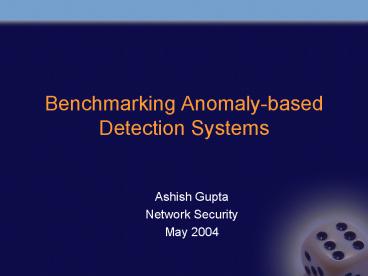Benchmarking Anomaly-based Detection Systems PowerPoint PPT Presentation
Title: Benchmarking Anomaly-based Detection Systems
1
Benchmarking Anomaly-based Detection Systems
- Ashish Gupta
- Network Security
- May 2004
2
Overview
- The Motivation for this paper
- Waldo example
- The approach
- Structure in data
- Generating the data and anomalies
- Injecting anomalies
- Results
- Training and Testing the method
- Scoring
- Presentation
- The ROC curves somewhat obvious
3
Motivation
- Does anomaly detection depend on
regularity/randomness of data ?
4
Wheres Waldo !
5
Wheres Waldo !
6
Wheres Waldo !
7
The aim
- Hypothesis
- Differences in data regularity affect anomaly
detection - Different environments ? different regularity
- Regularity
- Highly redundant or random ?
- Example of environments affect
010101010101010101010101 Or 0100011000101000100100
101
8
Consequences
One IDS Different False Alarm Rates
Need custom system/training for each environment ?
Temporal affects Regularity may vary over time ?
9
Structure in data
- Measuring randomness
10
010101010101010101010101 Or 0100011000101000100100
101
Measuring Randomness
Relative Entropy
Sequential Dependence
Conditional Relative Entropy
11
The benchmark datasets
- Three types
- Training data ( the background data)
- Anomalies
- Testing data ( background anomalies )
- Generating the sequences
- 5 sets, each set ? 11 files ( for increasing
regularity) - Each set ? different alphabet size
- Alphabet size ? decides complexity
12
Anomaly Generation
- Whats a surprise ?
- Different from the expected probability
- Types
- Juxta-positional different arrangements of data
- 001001001001001001111
- Temporal
- Unexpected periodicities
- Other types ?
13
Types in this paper
- Foreign symbol
- AAABABBBABABCBBABABBA
- Foreign n-gram
- AAABABAABAABAAABBBBA
- Rare n-gram
- AABBBABBBABBBABBBABBBABBAA
14
- Injecting anomalies
- Make sure not more than 0.24
15
The experiments
- The Hypothesis is true
16
- The hypothesis
- Nature of normal background noise affects
signal detection - The anomaly detector
- To detect anomalous subsequences
- Learning phase ? n-gram probability table
- Unexpected event ? anomaly !
- Anomaly threshold decides level of surprise
17
- Example of anomaly detection
AAA 0.12
AAB 0.13
ABA 0.20
BAA 0.17
BBB 0.15
BBA 0.12
AAC ? ANOMALY !
18
Scoring
- Event outcomes
- Hits
- Misses
- False alarms
- Threshold
- Decides level of surprise
- 0 ? completely unsurprising, 1 ? astonishing
- Need to calibrate
19
Presentation of results
- Presents two aspects
- correct detections
- false detections
- Detector operates through a range of
sensitivities - Higher sensitivity ? ?
- Need the right sensitivity
20
(No Transcript)
21
Interpretation
- Nothing overlaps ? regularity affects detection !
22
- What does this mean ?
- Detection metrics are data dependent
- Cannot say
- My XYZ product will flag down 75 percent
anomalies with 10 false hit rate ! - Sir, are you sure ?
23
Real world data
- Regularity index for system calls for different
users
24
- Is this surprising ?
- What about network traffic ?
25
Conclusions
Anomaly Detection Effectiveness
Data Structure
Evaluation is data dependent
26
Conclusions
Different system Or Change the parameters
Change in regularity
27
Quirks ?
- Assumes rather naïve detection systems
- Simple retraining will not suffice
- An intelligent detection can take this into
account. - What is really an anomaly ?
- If data is highly irregular, wont randomness
produce some anomalies by itself - Anomaly is a relative term
- Here anomalies are generated independently

